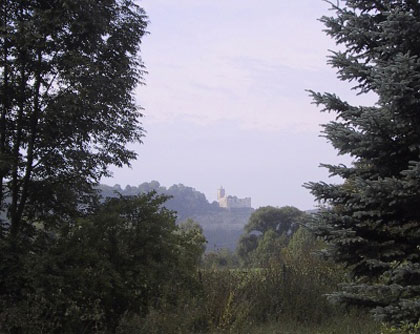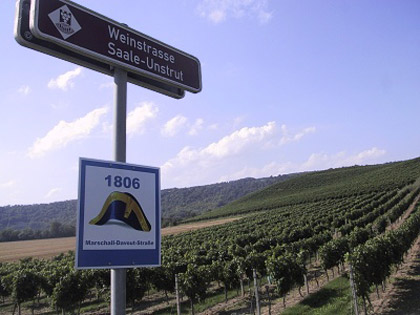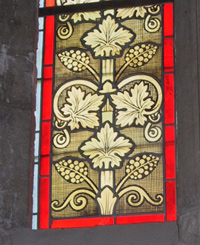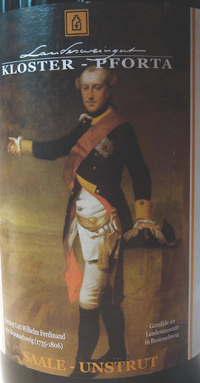How life plays out! The last column has not yet been posted on the web, and there I am, standing by the Saale and Unstrut rivers, looking out for what I discovered, experienced and described in my last column on a very ordinary day, in the Swiss village of Bubikon: "my first encounter with the Blauer Portugieser" from the smallest German wine region.
 |
| The Rudelsburg in the morning mist |
On the holiday trail to the Harz mountains - where German viticulture is finally over - we pitch our tent in Bad Kösen, so that in the early morning the Rudelsburg castle emerges from the mist in front of us. "There Saaleck, here the Rudelsburg, and down deep in the valley, there rushes between rocks through the old dear Saale; and mountains here and mountains there to the right and to the left, the Rudelsburg, that is a place to rave and to drink". Even today, this is still the theme song of the student corps that once founded the oldest umbrella organisation of German student fraternities at Rudelsburg Castle
(The song can be heard at: http://www.uni-stuttgart.de/hilaritas/LIEDER/TEXTE/dortsaal.html )
Vines are said to have once stood on the southern slope of the castle, but nothing can be seen of them any more. The last verse of the famous student song (1863) is now bashfully omitted: "What do we need the Rudelsburg, what do we need the Saale? We have Alt Heidelberg, in the beautiful Neckar valley - and mountains here and mountains there to the right and to the left, Alt Heidelberg, that's a place to get horribly drunk". In old engravings of student conviviality, the "lads" of the 19th century do not toast each other with wine glasses, but with beer mugs. So the gushing and drinking can hardly have referred to wine.
 |
| Vineyard on the Saale-Unstrut wine route |
But my interest is aroused: between Bad Kösen and the former Cistercian monastery "Sanctae Mariae ad Portam" - today "Schulpforta" - I discover for the first time the vineyards along the Saale-Unstrut wine route. So I have arrived in wine country after all. "Duke Carl Wilhelm Ferdinand von Braunschweig (1735-1806) had already greeted me the evening before on a bottle of semi-dry Pinot Noir from the Kloster Pforta vineyard. I only bought this wine because it is grown not far from the historic battlefield of Hassenhausen, where Napoleon once decisively defeated the Prussian army.
 |
| Church windows in Schulpforta with vine motifs |
Wine, culture, history and famous personalities: I have landed on the Saale/Unstrut! The Cistercians (at least their spirit and their pioneering work in viticulture) catch up with me. I think of Burgundy, of Eberbach Monastery (Rheingau), where my German wine friends took me, or of Heiligenkreuz Abbey in Austria. On an information board about the viticulture of Schulpforta I discover the Cistercian wisdom: "If you pour good, you see God in the wine". So far, however, I have not encountered God in the wine from Saale/Unstrut. But now I want to know: In the vinotheque of Schulpforta I buy two wines, a Pfortenser Köppelberg Portugieser QbA and a Blauer Zweigelt, Saalhäuser, QbA.
 |
| Carl Wilhelm Ferdinant of Brunswick - perished in the Battle of Jena and Auerstedt (1806) |
The Portugieser is really quite different from the wine I recently drank with zucchetti gratin with gorgonzola - namely rather velvety, light or "...simply knit, slightly artificial red cherry fruit, little substance, smoothed, fitting tannin, passable to decent finish." as the wine guide from Wein-Plus describes it.
So now I have found it, the Portugieser that is characterised in this or a similar way. Not the powerhouse I drank a few weeks ago.
But what fascinates me much more about Schulpforta than the wine is the educational culture that prevails here. Since the dissolution of the monastic community (1540), the large complex has served as an educational institution for an intellectual elite, shaped by the ideology of the respective rulers and the spirit of the times. This was the intention of the school's founder, Duke Heinrich V of Saxony. Nietzsche, Klopstock and Fichte were also once "educated" at the boarding school.
 |
| Re-encountering the Portugieser of Saale-Unstrut in the vineyard area |
Even the National Socialists set up an educational institution here (NAPOLA) for 16 years, until they were replaced by the rulers of the GDR, who turned it into an educational institution of socialist training. And even now, after the demise of "real-existing socialism", Schulporta is still a boarding school where boys and girls are educated to become good capitalists (I suppose!). Such educational persistence fascinates me, as I once survived 6 years of boarding school (albeit in Switzerland).
After this brief encounter with culture and wine from the Saale, we travel on to the Harz Mountains. Five days later, on my birthday, the second wine bought at the Pforta monastery for 22.50 Euros arrives on the table: Blauer Zweigelt 2003, QbA, dry Saalhäuser: "full-bodied, tobacco and vanilla aromas - Silver Prize 2nd State Wine Award 2005" And? What is this "Austrian" doing up north? It is an intensely ruby-coloured wine with a delicate, full-bodied taste, matured in barriques - but it is not a festive wine. It lacks the culture, grandeur and uniqueness that I believe I sense within the walls of Rudelsburg Castle and Pforta Monastery. But stones last for centuries, and even a good wine hardly lasts an evening.
Sincerely
Yours sincerely
Peter (Züllig)